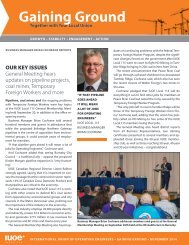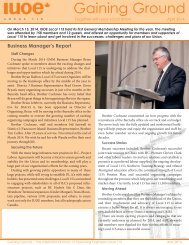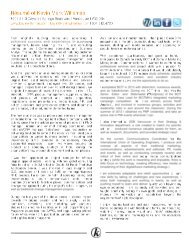A brief history of Unions in Canada
A look at the influence, history, and importance of Unions in Canada. Shared with permission of Dr. Brendan Sweeney and SAY Magazine.
A look at the influence, history, and importance of Unions in Canada. Shared with permission of Dr. Brendan Sweeney and SAY Magazine.
You also want an ePaper? Increase the reach of your titles
YUMPU automatically turns print PDFs into web optimized ePapers that Google loves.
law <strong>in</strong> 1944 that allowed workers to freely jo<strong>in</strong><br />
unions and compelled employers to barga<strong>in</strong><br />
with that union.<br />
Moreover, unions and employers were<br />
required to barga<strong>in</strong> ‘<strong>in</strong> good faith’, or <strong>in</strong> other<br />
words, with the honest <strong>in</strong>tent to achieve a<br />
fair and reasonable agreement with<strong>in</strong> the<br />
conf<strong>in</strong>es <strong>of</strong> the law that would m<strong>in</strong>imize<br />
strikes, lockouts, and other work stoppages,<br />
and help establish productive and healthy<br />
workplaces. This is <strong>of</strong>ten referred to as the<br />
‘post-war compromise’ between employers<br />
and workers. Dur<strong>in</strong>g the late 1940s and 1950s,<br />
workers <strong>in</strong> <strong>Canada</strong>’s steel, automotive, m<strong>in</strong><strong>in</strong>g,<br />
forest products, freight transportation, and<br />
construction <strong>in</strong>dustries jo<strong>in</strong>ed unions <strong>in</strong> record<br />
numbers.<br />
Two decades later, the federal and prov<strong>in</strong>cial<br />
governments adopted legislation that gave<br />
public sector workers the right to jo<strong>in</strong> unions.<br />
Throughout the late 1960s and 1970s federal,<br />
prov<strong>in</strong>cial, and municipal government employees,<br />
public school teachers, nurses and other<br />
health care workers, university and college<br />
pr<strong>of</strong>essors, police <strong>of</strong>ficers, fire fighters, and<br />
social services workers began to form unions.<br />
The proportion <strong>of</strong> workers unionized <strong>in</strong> <strong>Canada</strong><br />
grew rapidly dur<strong>in</strong>g this time, and reached a<br />
peak <strong>in</strong> the early 1980s.<br />
Today, three ma<strong>in</strong> types <strong>of</strong> unions exist <strong>in</strong><br />
<strong>Canada</strong>. The first group represents workers<br />
employed <strong>in</strong> the private sector (bus<strong>in</strong>esses<br />
that provide goods and services for a pr<strong>of</strong>it).<br />
Some <strong>of</strong> the biggest private sector unions<br />
<strong>in</strong> <strong>Canada</strong> <strong>in</strong>clude the United Steelworkers<br />
(USW), the United Food and Commercial Workers<br />
(UFCW), and UNIFOR, a new union formed<br />
by a merger <strong>of</strong> the Canadian Auto Workers<br />
(CAW) and the Communications, Energy, and<br />
Paperworkers (CEP). These unions negotiate<br />
collective agreements <strong>in</strong> <strong>in</strong>dividual workplaces,<br />
although <strong>in</strong> many cases they work hard to<br />
ensure that wages and work<strong>in</strong>g conditions are<br />
similar across specific <strong>in</strong>dustries. The members<br />
<strong>of</strong> these unions carry out a wide variety <strong>of</strong><br />
jobs and have an even wider variety <strong>of</strong> skills.<br />
The second group <strong>of</strong> unions represents workers<br />
employed <strong>in</strong> the public sector (government<br />
workers or workers employed by organizations<br />
that rely on government fund<strong>in</strong>g). Unlike the<br />
private sector, work <strong>in</strong> the public sector is<br />
geared towards provid<strong>in</strong>g important services<br />
for the public good, like schools, hospitals,<br />
and power plants. The Canadian Union <strong>of</strong> Public<br />
Employees (CUPE) and the Public Service Alliance<br />
<strong>of</strong> <strong>Canada</strong> (PSAC) are two <strong>of</strong> the largest<br />
public sector unions <strong>in</strong> <strong>Canada</strong>.<br />
These unions <strong>of</strong>ten represent specific pr<strong>of</strong>essions,<br />
like teachers, nurses, police <strong>of</strong>ficers,<br />
and fire fighters, or they may represent groups<br />
<strong>of</strong> workers employed by a specific branch <strong>of</strong><br />
the government (like Revenue <strong>Canada</strong> or prov<strong>in</strong>cial<br />
M<strong>in</strong>istries <strong>of</strong> Transportation). Because<br />
fund<strong>in</strong>g for their employers comes primarily<br />
from taxes, and the services they provide are<br />
so important to the public, their relationships<br />
with their employers <strong>of</strong>ten make the news.<br />
These unions negotiate contracts directly with<br />
employers (e.g. school boards), but also play<br />
an important role <strong>in</strong> protect<strong>in</strong>g and improv<strong>in</strong>g<br />
public services more broadly.<br />
The third group represents workers <strong>in</strong> a<br />
specific trade or occupation. They are <strong>of</strong>ten<br />
referred to as build<strong>in</strong>g and construction trade<br />
unions, and <strong>in</strong>clude electricians, elevator technicians,<br />
plumbers and pipefitters, and heavy<br />
equipment operators.<br />
The members <strong>of</strong> these unions are <strong>of</strong>ten found<br />
work<strong>in</strong>g on large construction projects, such<br />
as highways, airports, m<strong>in</strong>es, and factories.<br />
They also perform ma<strong>in</strong>tenance and repair<br />
work on large build<strong>in</strong>gs and important <strong>in</strong>frastructure.<br />
However, there are also several trade unions<br />
that represent workers outside <strong>of</strong> the construction<br />
<strong>in</strong>dustry, such as the actors’, musicians’,<br />
and screen writers’ associations.<br />
In addition to negotiat<strong>in</strong>g on behalf <strong>of</strong> their<br />
members, trade unions play an <strong>in</strong>strumental<br />
role <strong>in</strong> tra<strong>in</strong><strong>in</strong>g workers (<strong>of</strong>ten through apprenticeships),<br />
ensur<strong>in</strong>g that their members’ skills<br />
are up-to-date, and <strong>in</strong> work<strong>in</strong>g with employers<br />
to ensure that there are job opportunities for<br />
their members.<br />
Jo<strong>in</strong><strong>in</strong>g or becom<strong>in</strong>g <strong>in</strong>volved with a union<br />
is an important decision for young workers.<br />
<strong>Unions</strong> can be very helpful <strong>in</strong> access<strong>in</strong>g work<br />
and tra<strong>in</strong><strong>in</strong>g, ensur<strong>in</strong>g that workers receive fair<br />
wages and benefits, and provid<strong>in</strong>g a voice for<br />
work<strong>in</strong>g peoples.<br />
Many unions, particularly those work<strong>in</strong>g <strong>in</strong><br />
northern resource and <strong>in</strong>frastructure projects,<br />
have also begun to develop relationships with<br />
local Aborig<strong>in</strong>al groups to help improve employment<br />
and tra<strong>in</strong><strong>in</strong>g prospects and m<strong>in</strong>imize<br />
the impact <strong>of</strong> development. For example, at<br />
one m<strong>in</strong>e <strong>in</strong> Labrador, the union and employer<br />
negotiated clauses that made Inuit and Innu<br />
dialects <strong>of</strong>ficial languages <strong>in</strong> the workplace<br />
and established National Aborig<strong>in</strong>al Day as a<br />
paid holiday.<br />
So don’t be afraid to ask questions or discuss<br />
these issues with co-workers and union<br />
representatives if given the opportunity. There<br />
are millions <strong>of</strong> Canadians who are happy that<br />
they did.<br />
Many unions, particularly<br />
those work<strong>in</strong>g <strong>in</strong> northern<br />
resource and <strong>in</strong>frastructure<br />
projects, have<br />
also begun to develop<br />
relationships with local<br />
Aborig<strong>in</strong>al groups to<br />
help improve employment<br />
and tra<strong>in</strong><strong>in</strong>g prospects<br />
and m<strong>in</strong>imize the impact <strong>of</strong><br />
development.<br />
SAY - LABOUR Special 2013 • 21

















